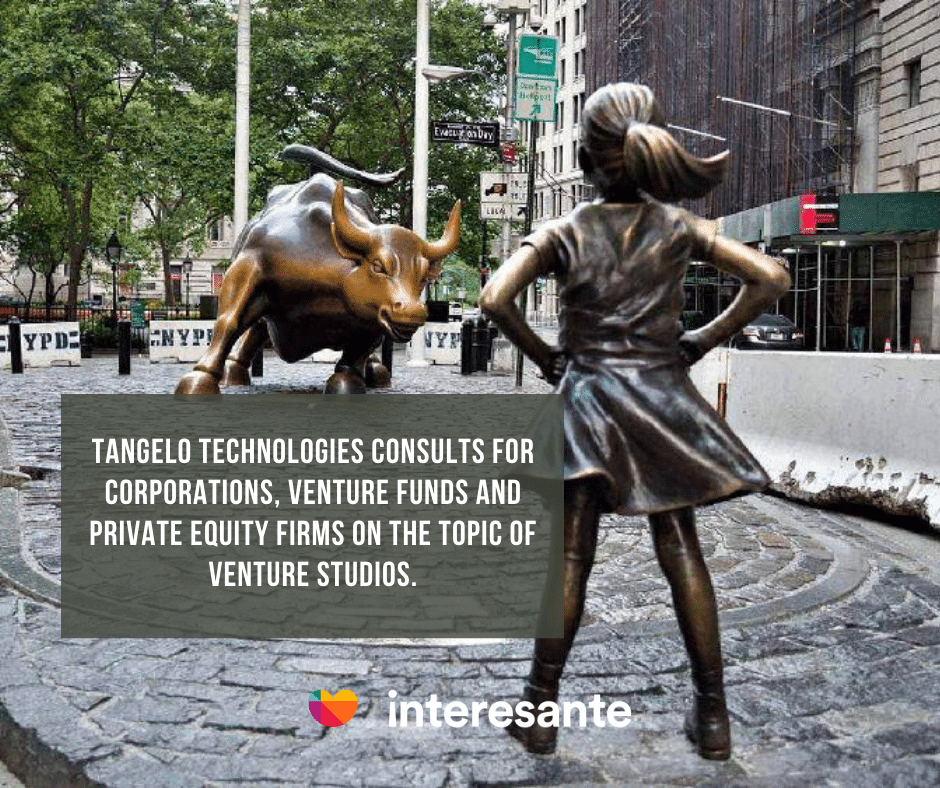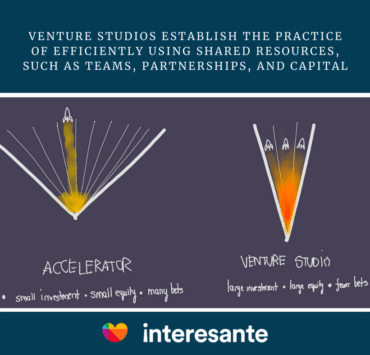Editor-in-Chief @ Interesante
Now more than ever, we see several variations of venture-building taking shape. As a Venture Studio, Tangelo provides analysis and introduction to the top venture studio models.

What is a Venture Studio?
Venture Studios work alongside existing products or business ideas from founders, iterate those ideas, and assign internal teams to develop the product by allocating engineers and advisors’ teams that can accelerate the time-to-market. Venture Studios often see an idea through from conception to a successful company.
They’ve nailed down the practice of efficiently using shared resources, such as teams, partnerships, and capital, to launch products or solutions that then operate as fully autonomous companies.
Additionally, venture studios commonly develop multiple projects in parallel and then select the most promising ones to continue with. Once focusing on the most promising model, the studio applies internal solutions to multiple startups. As such, partner companies often develop a connection not only with the Venture Studio but also among each other.
Venture Studios hit the ground running and develop many systems, models, projects, and processes. Tasks tied to the Venture Studio may involve pre and post-launch phases.
Venture Studios: Responsibilities
Their responsibilities range from but are not limited to:
- Raising capital
- Staffing resources
- Conducting market research
- The building and iterating products/services
- Branding
- Customer development
- Running effective marketing and sales campaigns
3 Venture Studio Models To Know
Let’s delve further into the Venture Studio world, where there are multiple options available. Having roots in venture capital firms, venture studios are decisively different. They’re much more involved in the day-to-day operations of the company partner than venture capital firms. They maintain deeper partnerships with companies, whereby they become aggressively hands-on in management, development, deployment, scale, and market.
«There is a range of variations between the venture studios out there in the market. Each venture studio aligns to a defined model.»
Some may ask for more equity than others, while others may have prerequisites. Furthermore, some venture studios work exclusively on seed-stage investments, while others work with more mature ventures. There are some venture studio variations in the market, along with different forms of partnership.
In general, there are three categories of venture studios to keep in mind when looking for a substantial partnership. Below are three models to which venture studios generally align:
In-House Venture Studios
Partnership Model
Primarily larger corporations (e.g., Fortune 500, etc.)
Goals
For the partnering corporation, the goal of building an internal start-up to innovate new ideas essentially offers ease of mobility and agility to develop new solutions and stay competitive with the smaller ventures that could potentially disrupt the market. Overall, the idea is to disrupt internally before being disruptive externally.
Pros
- Sufficient Funding and Core Resources: Corporations can provide core resources that range from financial management to legal counsel.
- More Entrepreneur, Less Admin: For venture studios, this means providing strategic value and an in-house entrepreneur and technical experts to oversee and/or implement the end-to-end processes. The majority of the core resources are available in-house.
- Exit Opportunities: An immediate exit if the venture becomes successful.
Cons
Office Cultural Biases: In-house or corporation venture studios are often subject to internal cultural biases within the company.
Conflicting Perspective: Identifying the solution and coming to an agreement on the parameters could be both potentially conflicting and rewarding. The ‘neutral’ third party attempting to disrupt the company internally may be difficult to identify the impact.
Risk, Compliance, and Legal Regulations:
Corporate venture studios must negotiate for a valid space to implement their operations, especially if it goes against the traditional methods of how the corporation runs its business.
The venture being housed under the corporation may also be subject to certain regulatory standards.
Examples
Pre hype
Production/Factory Venture Studios
Partnership Model
Primarily work with small ventures (e.g., startups to SMB companies) that have revenue and offer to provide operational services to develop and grow the product or service.
Goals
Depending on the type of venture and what stage the company is in, these venture studios may ask for equity share and/or a fixed duration of revenue share.
As they offer up direct talent and services, either on their own or as a venture arm of an existing larger corporation, there may be certain prerequisites that they actively look for in partners.
Pros
Speed, Scalability, and Efficiency
In these production houses, they commonly allocate their effort by scalable methods to ramp up the growth of the company. This in turn not only accelerates the growth and valuation of the company but also allows opportunities to test different ideas and pivot quickly for new solutions.
Specialized Capabilities
As these Venture Studios are often working on multiple ventures at the same time, to increase the efficiency, the resource, and talent in which they draw upon are specialized and segmented. With clear structure and processes, timely deliveries along with the quality of output should be a status quo.
Get Things Done Mentality
If you know what your venture needs and what specific development areas need extra capital, production venture studios are a great option, as they have an optimized, get-things-done mentality. They are ready to drive your idea through to the finish line.
Cons
Cookie Cutter Template
In exchange for speed, efficiency, and scalability, some venture studios take on the practice of templating frameworks and products to leverage in other projects. A potential downside to this approach is cookie-cutter templating that could offset creativity.
Status Quo Thinking
With most processes and deliverables standardized, the time and bandwidth of available resources distributed across multiple projects can produce standard outputs and solutions. Essentially, there can be a lack of ‘out-of-the-box thinking that entrepreneurship is often equated to.
Strict Criteria
Production Venture Studios maintain strict criteria in what types of ventures they like to partner with. For example, they may focus on products/services aligned to a specific agency or a certain cause. They may also perform ‘venture building as a service fee rather than taking equity in certain cases.
Production Venture Studios typically partner with startups or companies with revenue traction.
Examples
Full-Stack Venture Studios
Partnership Model
Primarily with Startups and adhere to a parallel entrepreneurship partnership.
Goals
This is perhaps the most ideal and difficult form of a venture-building partnership. The entrepreneur and the venture studio are coming together as equity stakeholders and driving the idea, product/service, and/or company forward. Without necessarily providing direct cash capital, the venture studio can accelerate the growth and value without the need for seed-stage funding.
The venture studio is also able to directly exit or IPO. Realistically, adjacent partnerships may be needed to provide additional funds to supplement the company’s areas needing additional resources. This is commonly achieved through an angel.
Pros
Skin-in-the-Game Mentality
With limited resources and bandwidth, full-stack venture studios come into a partnership with a skin-in-the-game mentality. Immediately knowing the potential outputs and having equitable ownership, the studio and its resources are placing the same value of investment into a venture
Direct Exit / IPO
Depending on the capabilities, bandwidth, and available resources, a full-stake venture studio’s optimal outcome does not necessarily have to seek additional funding.
Instead, there is a high potential for an exit or an IPO. Realistically, full-stack venture studios can grow a company with a valuation in which additional funding remains relatively small as a means to avoid ownership dilution.
Creative Output
Unlike production venture studios where some of the outputs are templated, full-stack venture studios can put additional time and effort to produce more creative and out-of-the-box outputs.
Cons
Full-Stack
Every full-stack venture studio has its own definition of what types of resources are considered core and fundamental to growing a venture. This, in many ways, either opens a breadth of opportunities to work with various stages of companies and similarly, also closes the scope of opportunities.
Narrow in Scope
Limited by resources, full-stack venture studios have a narrow scope in evaluating their ventures and potential endeavors. They have specific metrics and criteria for deciding who to partner with and what the process to market might look like.
Inherited Company Culture
This also contributes to the fact that the venture studio’s culture will also ultimately transfer into the foundation of the venture itself. In many ways, the visions of how a venture studio is implemented and design will directly impact how a venture is created.















